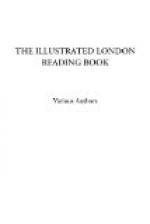[Illustration: THE FALLS OF NIAGARA.]
The great cataract is seen by few travellers in its winter garb. I had seen it several years before in all the glories of autumn, its encircling woods, happily spared by the remorseless hatchet, and tinted with the brilliant hues peculiar to the American “Fall.” Now the glory had departed; the woods were still there, but were generally black, with occasional green pines; beneath the grey trunks was spread a thick mantle of snow, and from the brown rocks inclosing the deep channel of the Niagara River hung huge clusters of icicles, twenty feet in length, like silver pipes of giant organs. The tumultuous rapids appeared to descend more regularly than formerly over the steps which distinctly extended across the wide river. The portions of the British, or Horse-shoe Fall, where the waters descend in masses of snowy whiteness, were unchanged by the season, except that vast sheets of ice and icicles hung on their margin; but where the deep waves of sea-green water roll majestically over the steep, large pieces of descending ice were frequently descried on its surface. No rainbows were now observed on the great vapour-cloud which shrouds for ever the bottom of the Fall; but we were extremely fortunate to see now plainly what I had looked for in vain at my last visit, the water-rockets, first described by Captain Hall, which shot up with a train of vapour singly, and in flights of a dozen, from the abyss near Table Rock, curved towards the east, and burst and fell in front of the cataract. Vast masses of descending fluid produce this singular effect, by means of condensed air acting on portions of the vapour into which the water is comminuted below. Altogether the appearance was most startling. It was observed at 1 P.M. from the gallery of Mr. Barnett’s museum. The broad sheet of the American Fall presented the appearance of light-green water and feathery spray, also margined by huge icicles. As in summer, the water rushing from under the vapour-cloud of the two Falls was of a milky whiteness as far as the ferry, when it became dark and interspersed with floating masses of ice. Here, the year before, from the pieces of ice being heaped and crushed together in great quantities, was formed a thick and high bridge of ice, completely across the river, safe for passengers for some time; and in the middle of it a Yankee speculator had erected a shanty for refreshments. Lately, at a dinner party, I heard a staff-officer of talent, but who was fond of exciting wonder by his narratives, propose to the company a singular wager,—a bet of one hundred pounds that he would go over the Falls of Niagara and come out alive at the bottom! No one being inclined to take him up, after a good deal of discussion as to how this perilous feat was to be accomplished, the plan was disclosed. To place on Table Rock a crane, with a long arm reaching over the water of the Horse-shoe Fall; from this arm would hang, by a stout rope, a large bucket or cask; this would be taken up some distance above the Fall, where the mill-race slowly glides towards the cataract; here the adventurer would get into the cask, men stationed on the Table Rock would haul in the slack of the rope as he descended, and the crane would swing him clear from the cataract as he passed over. Here is a chance for any gentleman sportsman to immortalize himself!




